Tapas are an essential part of Spanish culture. And, unsurprisingly, cheese is an essential part of tapas. Read on to discover our ultimate list of Spanish cheeses for tapas.
SEE ALSO: Nine best Swiss cheeses that are guaranteed to knock your socks off →
What are tapas?
A tapa is an appetizer or snack in Spanish cuisine. Indeed, tapas may be cold (e.g. cheese) or hot (e.g. patatas bravas). In some bars and restaurants across Spain, and the rest of the world, tapas have evolved from being simple snacks to a much more sophisticated gastronomic offering. Indeed, they are often combined in more modern establishments to make a full meal.
While the type of food on offer for tapas can vary significantly from one restaurant to another, cheese is almost always part of the meal. Without further ado, let’s have a look at our picks for the best Spanish cheeses for tapas.
Manchego
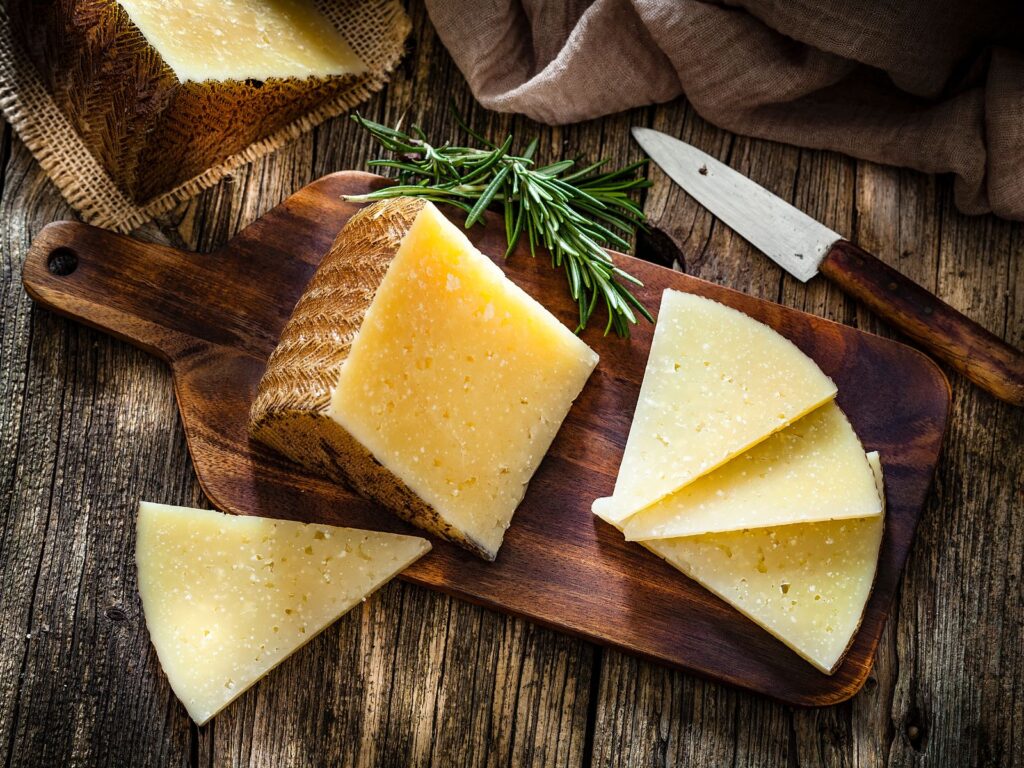
Manchego is Spain’s most popular cheese. Actually, it accounts for one third of the country’s entire cheese production. Originating from La Mancha in central Spain, this pressed uncooked cheese is traditionally made using the rich, fatty raw milk of Manchega sheep. Moreover, it is instantly recognisable due to its herringbone rind formed by dried esparto grass moulds.
In a similar way to French Comté and Swiss Gruyère, Manchego demonstrates an incredible range of flavours. Be prepared for symphonic strokes of fruits and nuts, along with zesty undertones of piquancy. Furthermore, the esparto grass imparts aromas of dried herbs to the cheese.
Unsurprisingly, Manchego’s intense flavour and crumbly texture make it an ideal table cheese. Round up your tapas board with black olives, sun-dried tomatoes and crusty bread. And wash it all down with a robust red wine or dry Sherry.
Torta del Casar
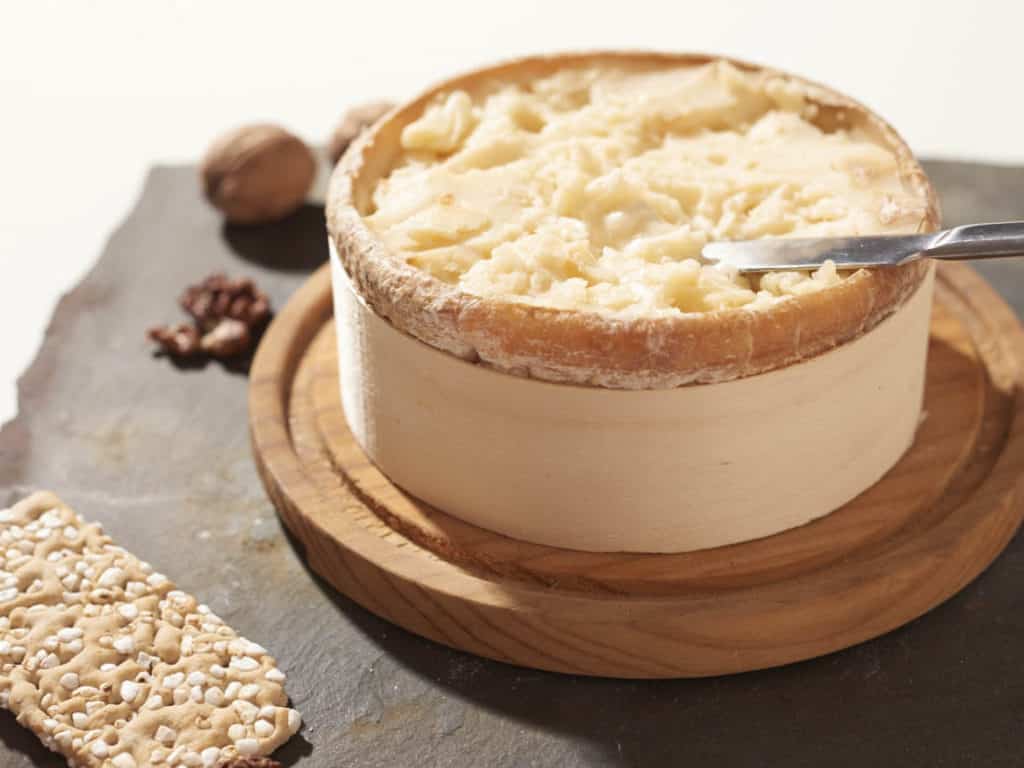
Without a doubt, Torta del Casar is one of Spain’s most popular soft cheeses. Actually, it gets its name from its unique shape. According to Spanish legends, shepherds who originally made this cheese realised that its interior would be almost liquid when the cheese ripens.
As a result of this, the middle of the cheese would sink. Hence, the shepherds used the word atortado (meaning cake-shaped) when referring to this particular cheese.
With a light and thin semi-hard rind, the cheese’s main feature is its decadently creamy texture. At optimal ripeness, the insides of Torta del Casar have been known to pour out from any crack in the rind. With its characteristic aroma and intense and well-developed taste, it melts in your mouth and is the perfect centrepiece cheese for tapas.
The best way to enjoy this decadent cheese is to bring it to room temperature, and use a sharp knife to open the top of the rind. Then, you can spread the oozy insides on fresh or lightly toasted bread. If, by some miracle, you don’t finish the cheese in one sitting, you can place the rind back on and store it in a cool place.
Mahón Curado
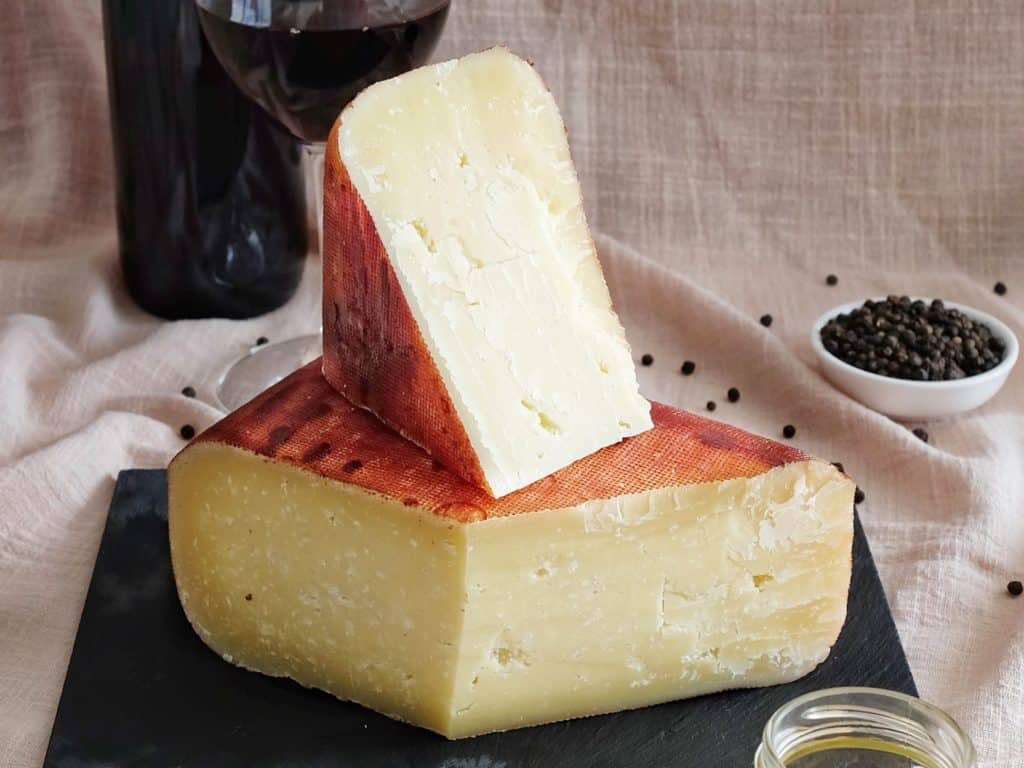
Next, we find the first cow’s milk cheese on our list, Mahón Curado. Mahón is a pressed uncooked cheese that finds its roots on the island of Menorca. Mahón is released for consumption at various stages of maturation. Local artisans in Menorca make this cheese in square-shaped blocks that they then mature in local cellars.
Mahón is released for consumption at various ages. For your tapas night, you will want a 5 month Mahón Curado. At this age, the paste is darker and becomes crumbly with a spattering of crunchy lactose crystals. Moreover, the cheese’s flavour is incredibly complex with notes of wood, caramel, nuts and spice that mirror the Mediterranean seascape.
Enjoy this hard crumbly cheese the traditional way; thinly sliced with some extra virgin olive oil and cracked pepper. And the perfect beverage pairing for Mahón is a local Tempranillo or Rioja.
Queso Azul de Valdeón
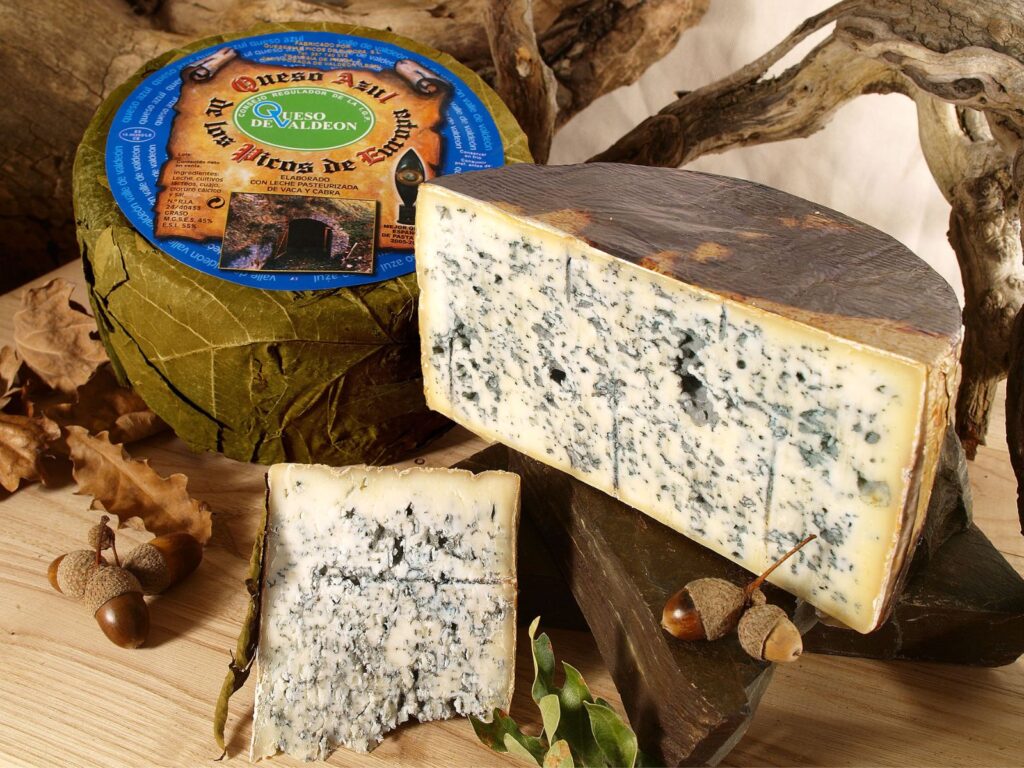
It’s about time we talked about a blue cheese, right? Meet Queso de Valdeón, a blue cheese made all year round with cow’s and goat’s milk in the Picos de Europa mountains. Cheese production in the Valdeón valley dates back to pre-Roman times, and goat milk was used as a raw material in this period.
This robust Spanish blue cheese is wrapped in plageru (sycamore) leaves and has an aggressive spattering of blue veins. Overall, its flavour is intensely blue, with slightly lactic and savoury notes that become more pronounced as the cheese matures.
Queso Azul de Valdeón is best served spread on warm crunchy bread accompanied with a glass of Gruner Veltliner, Riesling, or a sweeter dessert wine such as Sauternes or Muscat.
Garrotxa
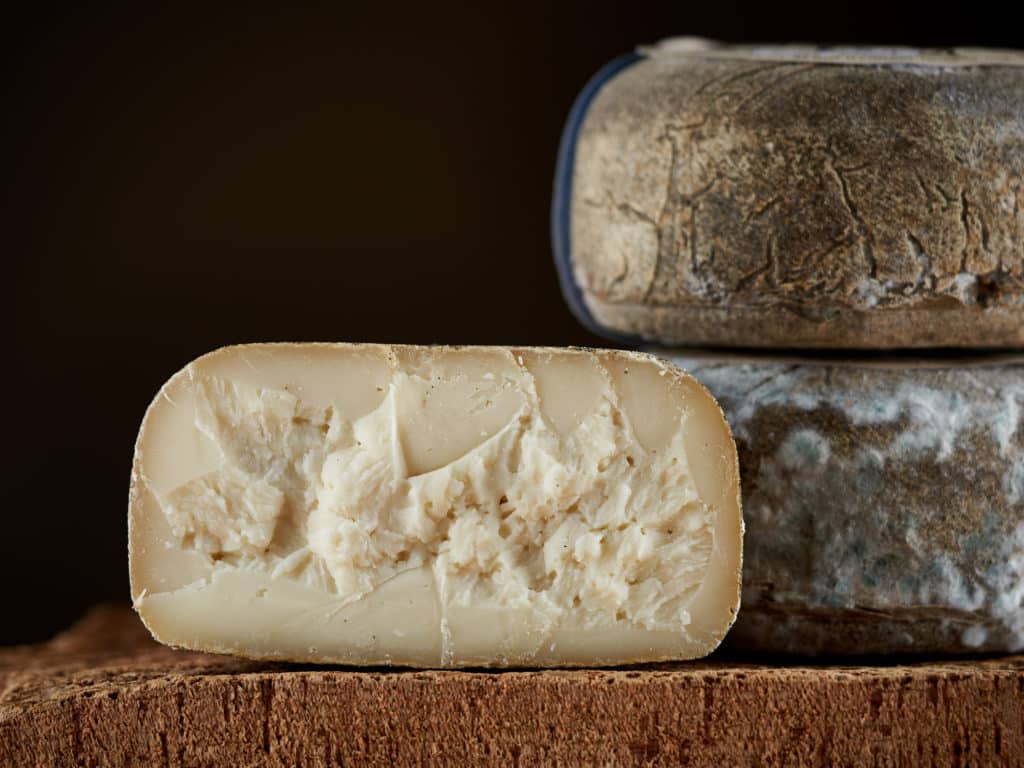
Garrotxa is a beautiful pressed uncooked cheese made using pasteurised goat’s milk in the Garrotxa region of Catalonia. In the 1970’s, this traditional cheese had all but disappeared from circulation. However, a small number of artisanal cheesemakers in the region decided to revive it in 1981. Nowadays, a handful of artisans in Catalonia have mastered the craft of maturing Garrotxa.
At 6 months, the cheese develops a velvety, almost furry, natural rind. On the outside, it looks like a river stone and has a damp woody aroma. In stark contrast, it has a pristine white paste with a dense buttery texture. Furthermore, its mild and milky aroma reinforces that this is a truly surprising cheese. On the palate, it is both sweet and savoury, with notes of herbs and nuts and a subtle piquant finish.
This is one of the rare instances where we recommend removing the cheese’s rind before serving. This gorgeous Catalonian beauty pairs magically with walnuts, honey and Spanish ham as a part of a tapas spread. In addition to this, you can serve Garrotxa with simple reds and crisp whites like Vinho Verde and Cava, or try it with a summery wheat beer.
Arzúa-Ulloa
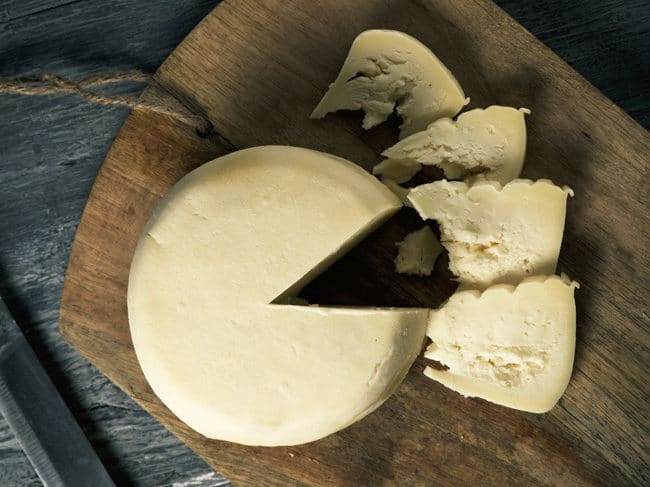
Arzúa-Ulloa is a soft cheese that originates from the Galicia region. For centuries, local artisans have made this cheese using either raw or pasteurised cow’s milk. Arzúa-Ulloa is typically shaped like a convex lens and has a very thin and elastic edible rind.
Underneath, its soft paste is straw coloured and usually quite compact. The young cheese has a milky aroma and flavours reminiscent of yoghurt, vanilla and walnut. On the other hand, the aged version is much more complex with a slightly bitter aftertaste.
Serve this delightful soft cheese with a packet of artisanal Piquitos (bread sticks) and dig into the wheel of cheese to scoop out your bounty. You will want to leave your little wheel of Arzúa-Ulloa at room temperature for at least 24 hours before serving. That way, the paste will be very soft and almost oozy by the time you’re ready to enjoy it.
Cabrales
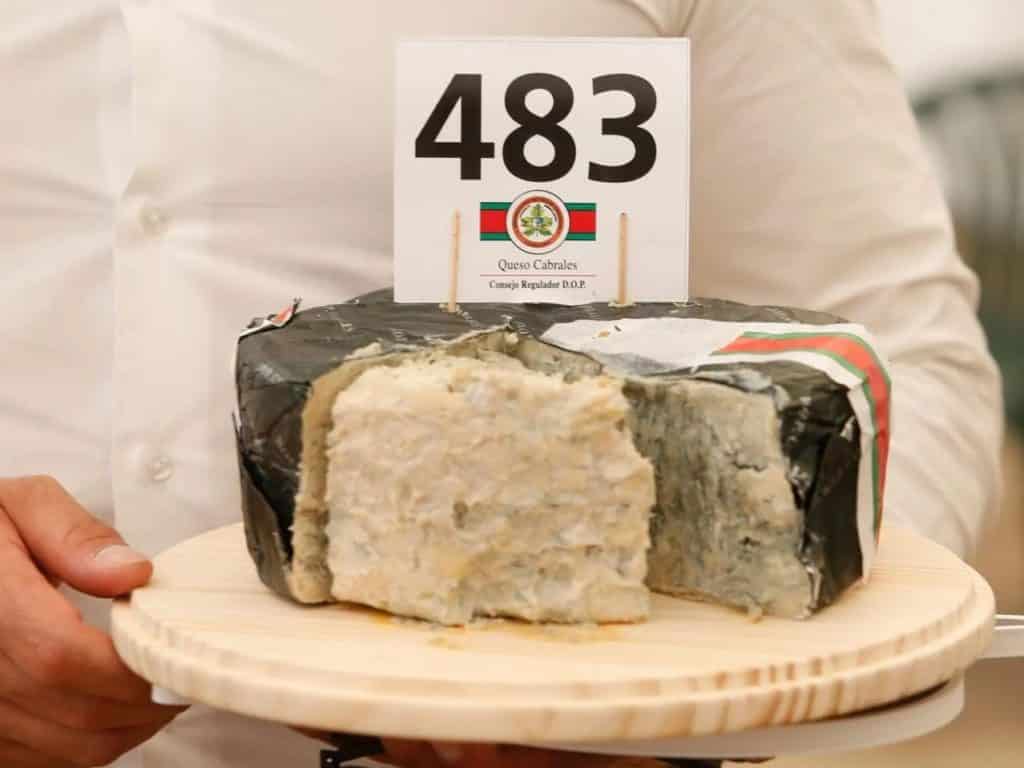
Cabrales is a semi-hard fatty blue cheese that originates from the administrative region of Cabrales and some small towns in the Upper Peñamerella region. Those areas are located at the foot of the Picos de Europa mountains in Asturias.
The cheese can be made from unpasteurised cow’s milk or blended with goat and/or sheep milk. Wheels of Cabrales are aged between two and six months in naturally formed limestone caves. Chilly and humid conditions in the caves facilitate the growth of bluish-green Penicillium mould.
When ripe, Cabrales has a smooth texture, punctuated with holes and pockets of blue. The creamy paste is studded with crunchy granules of crystallised amino acids. At 6 months, the cheese is characterised by its strong, penetrating aroma and complex, acidic, slightly savoury taste.
Unsurprisingly, it pairs well with a full-bodied red wine, salami and something sweet such as fresh figs, honey and sweet Sherry. Moreover, you can serve Cabrales on your tapas plate alongside a sliced baguette, crackers, or stone fruit.
Idiazabal
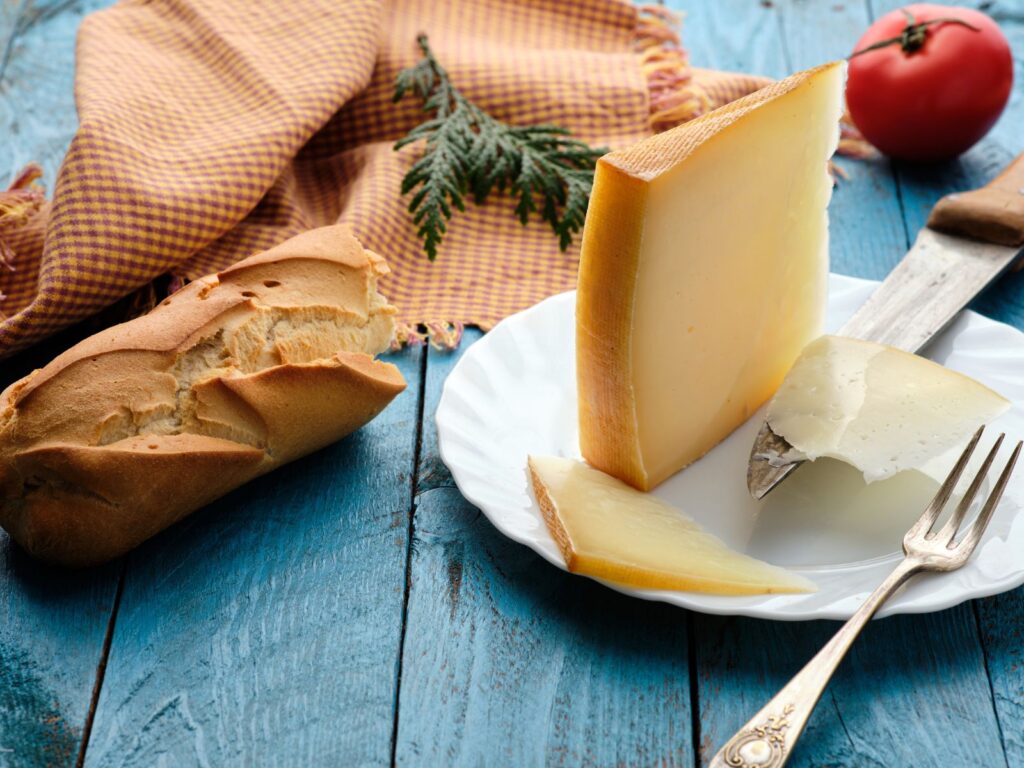
Idiazabal is a traditional, farmhouse, pressed uncooked cheese made from raw milk of Latxa or Carranza sheep in the Basque and Navarre regions of northern Spain. The cheese gets its name from the local village of Idiazabal.
In summer, their sheep migrate to higher pastures to graze on new grass. During those months, the artisanal cheese makers milk the sheep, make the cheese and leave it to mature for a minimum of 2 months.
The cheese has a compact texture, with a few pinprick holes. It is dry, but not too crumbly with a pleasantly oily mouthfeel. The characteristic, smoky flavour is the result of the cheeses having been stored near the fireplaces. There were no chimneys in the simple mountain huts, so the cheeses absorbed the sweet, aromatic smoke. The taste of the cheese is reminiscent of burnt caramel and bacon.
Traditionally, the locals enjoy this historic cheese on toasted bread, over salted crackers or grated in salads. Idiazabal pairs well with a simple red wine like Tempranillo, dry cider, or Saison beer.
San Simón
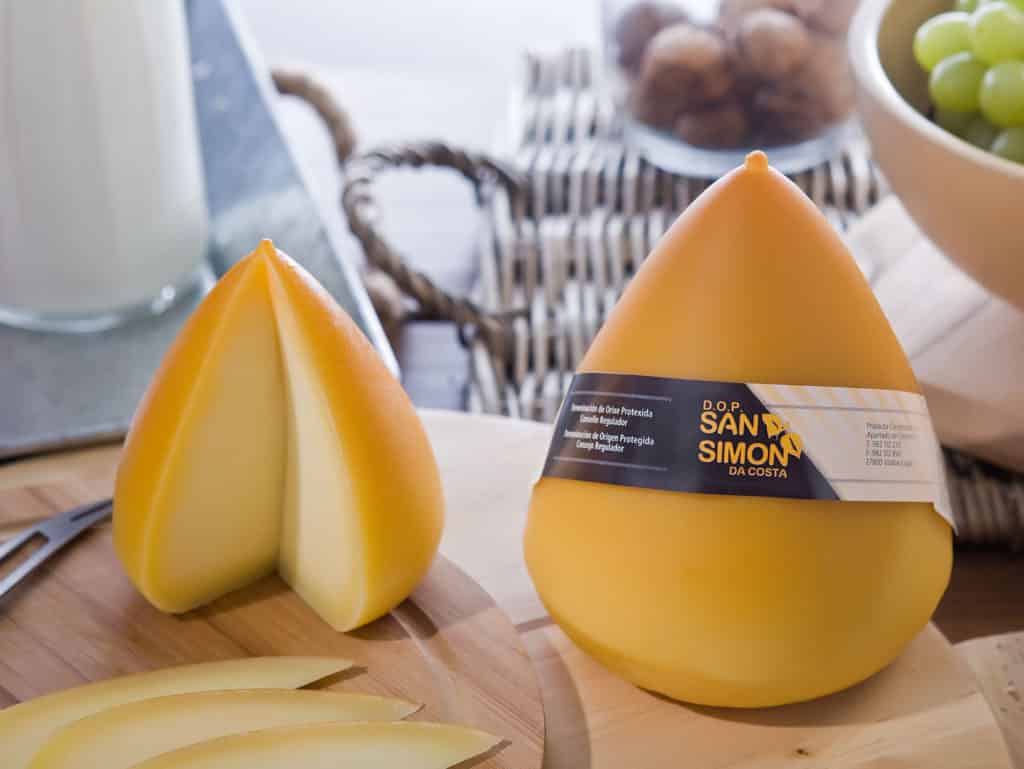
The final cheese on our list might just be the most criminally underrated Spanish cheese. While San Simón might not be as well-known as some of the cheeses we’ve mentioned so far, it is definitely just as spectacular.
This traditional smoked cheese originates from Galicia in north-western Spain. To this day, artisanal cheesemakers make San Simón using local milk and unique conical moulds.
After maturing for 2 months, the cheese develops a natural rich ochre rind around a semi-firm paste. More often than not, the interior of the cheese presents with small opening and is pale yellow in colour. Overall, San Simón has a fairly mild flavour with notes of butter and delicate smoke.
It can be enjoyed with fruit-based desserts. Serve with celery, fresh bread, hazelnuts or green apple tart. Furthermore, San Simón melts spectacularly and adds great flavour to casseroles and grilled cheese sandwiches. Serve as part of tapas with chorizo, olives and Marcona almonds. Finally, you can pair this gorgeous cheese with a glass of a local white wine or brut Cava.
What’s your favourite Spanish cheese?
We hope that you enjoyed reading our list of the best Spanish cheeses for tapas. Without a doubt, cheese is an integral part of tapas in Spanish culture.
And their incredible range of artisanal cheese means that we’ve always got many options to choose from. Did your favourite Spanish cheese make our list? Drop us a comment below. We’d love to hear from you.
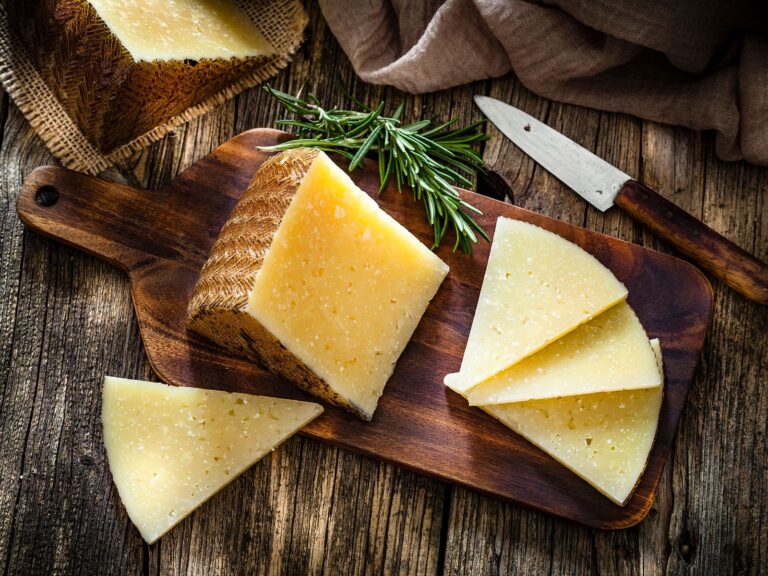
My favorite Spanish cheese is Cana de Cabra
Just looked up Cana de Cabra and it looks amazing! Will be seeking this cheese out next time we’re in Europe!